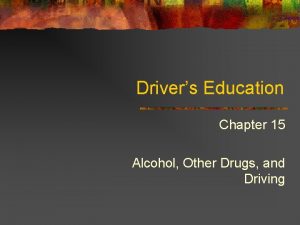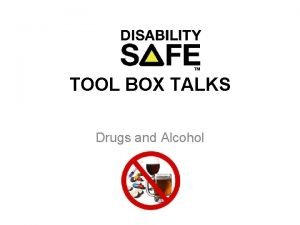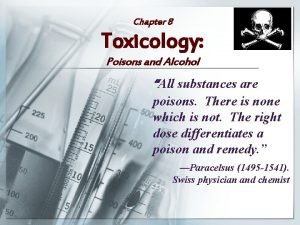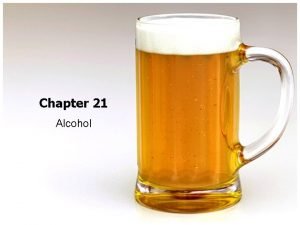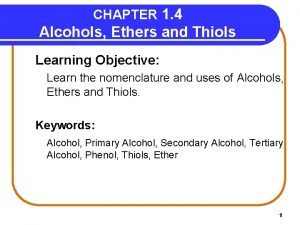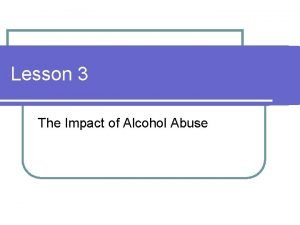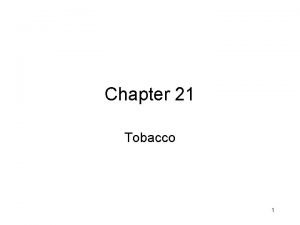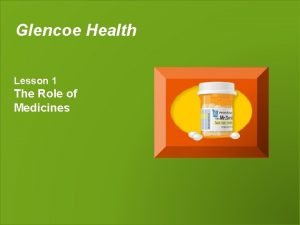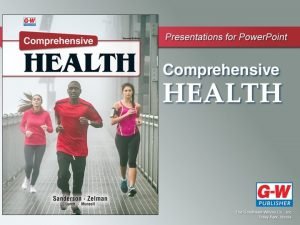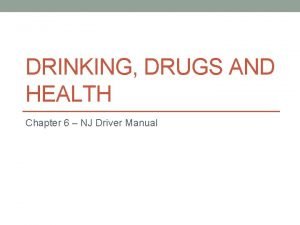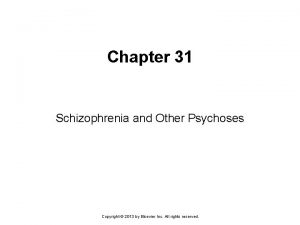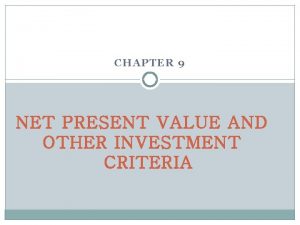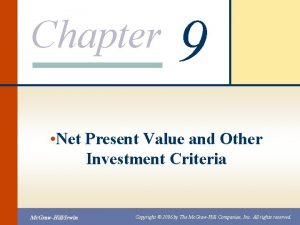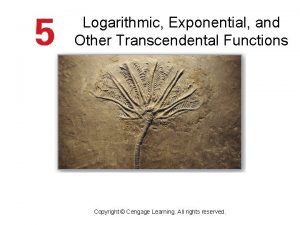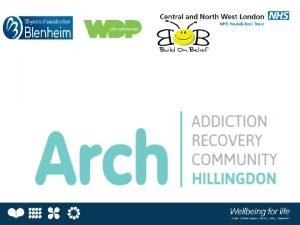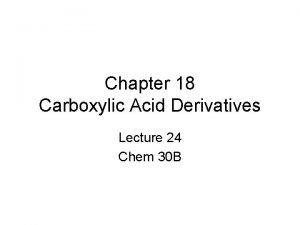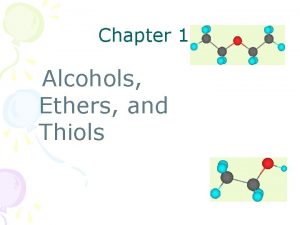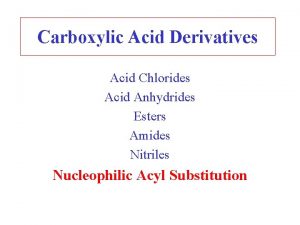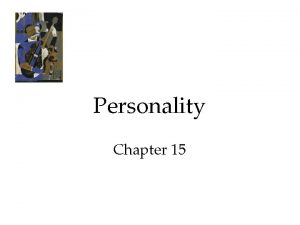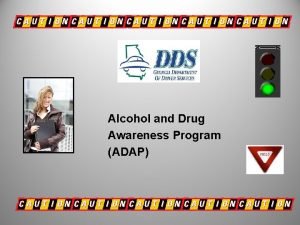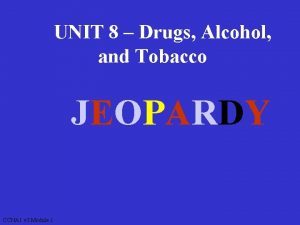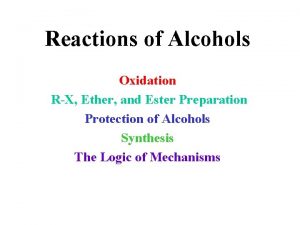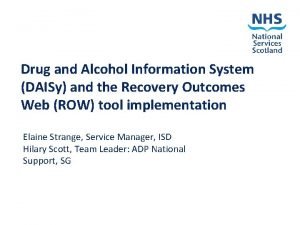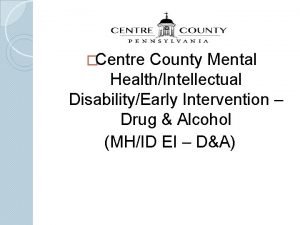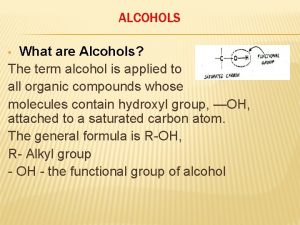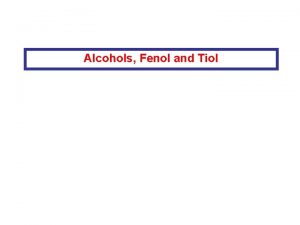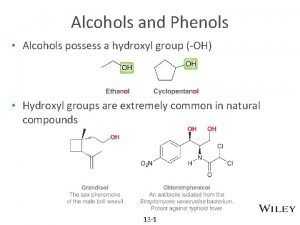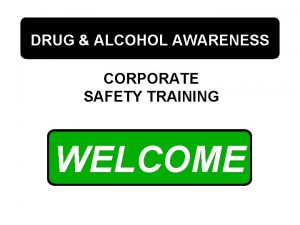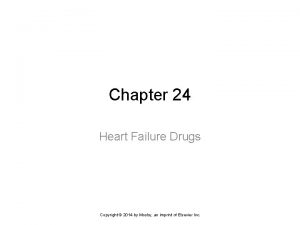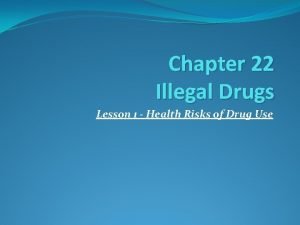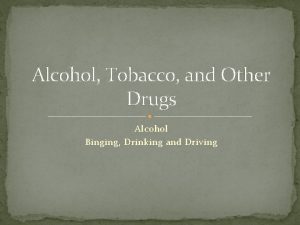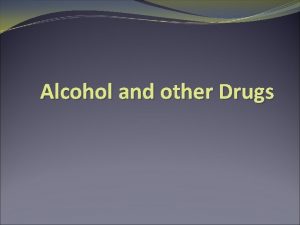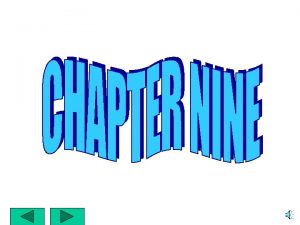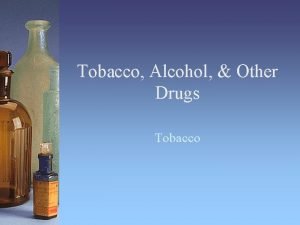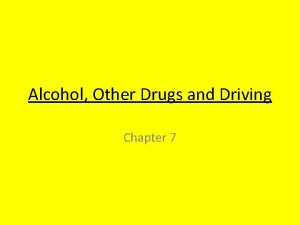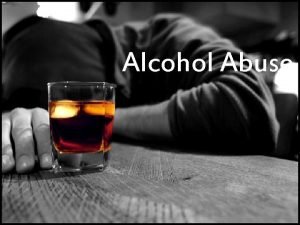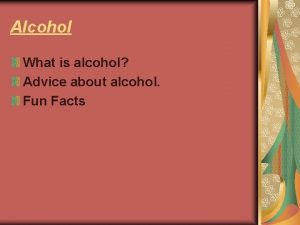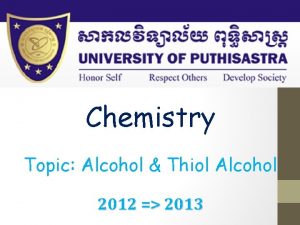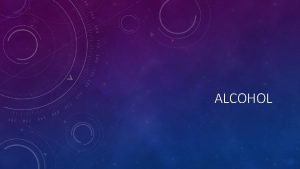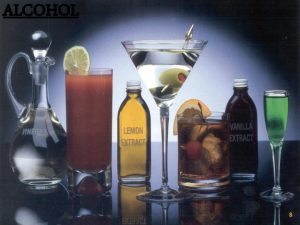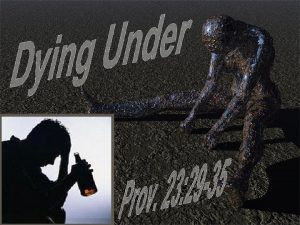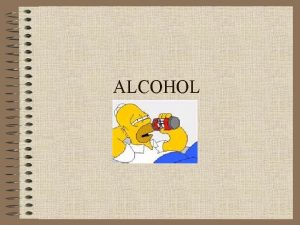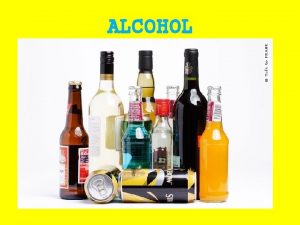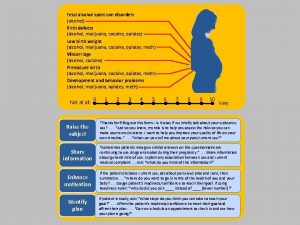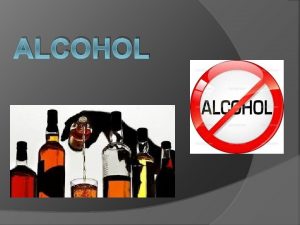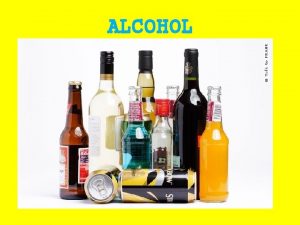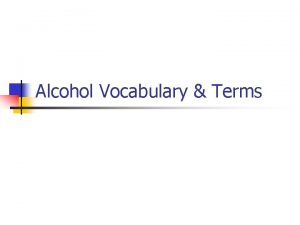Chapter 4 ALCOHOL AND OTHER DRUGS Drugs A














































- Slides: 46

Chapter 4 ALCOHOL AND OTHER DRUGS

Drugs A drug is any chemical substance other than food or water that affects the mind or body. a substance that people take to produce a change in their thinking, consciousness, emotions, bodily functions or behavior. Drug Abuse—using drugs in such a way that they harm one’s health, impair one’s physical or mental functioning, or interfere with one’s social life. No drug is good or bad in and of itself.

Drugs and Culture Drugs can be defined as good or as harmful. Definitions of drugs vary from society to society Alcohol part of western culture Peyote use as a religious ritual among Native Americans Coca and South America Definitions vary over time It is not the objective conditions of drugs—such as whether or not they are harmful—that makes their use a social problem. Rather, it is the surrounding subjective concerns that establish them as problems. Subjective concerns are not fixed, but change over time.


The Scope of the Problem A drug is a substance that people take to produce a change in their thinking, consciousness, emotions, or bodily functions or behavior. People take many substances to cause such changes. Essential difference among these substances is not which ones they use, but whether a substance is socially acceptable or disapproved of. Far from being an antidrug society, we are actually a pro-drug society.

Drugs and Social Diversity Definitions of drugs have varied over time in the United States Attitudes toward cocaine Cocaine early on was seen as a medical panacea Racism and cocaine usage Founding Fathers and hemp Immigrants and drug use

Drug Abuse as a Personal or Social Problem When drug use interferes with someone’s health or how that person gets along in life, we consider this a personal problem. If large numbers of people become upset about a drug, and want something done, then that drug becomes part of a social problem. Nicotine and Alcohol as social problems. Smoking is the single most preventable cause of premature death in the U. S. Alcohol is more dangerous than its broad social acceptability would imply. Changing views of Alcohol

Changing Views of Alcohol is one of the most widely used drugs Alcohol was important in colonial America Alcohol became associated with undesirable immigrants The Temperance Movement The 18 th Amendment and Prohibition Organized crime In 1933 Prohibition ended with the passage of the Nineteenth Amendment

The Extent of Drug Use Most everyone uses some type of drug legal or illegal In 2007 government survey 80% of the population over the age of twelve used some illicit drug Declined after 1980 and rose slightly after 2000

Why do People Use Drugs? 5 reasons behind use: 1. Therapeutic use 2. Recreational use 3. Escapism 4. Spiritual or psychological use 5. Social Conformity

Use and Abuse The distinction between using a drug from abusing a drug Use that goes against accepted medical practices Effect of the drug • Mental harm • Physical harm • Social harm

Addiction and Dependency Addiction – a physical or psychological craving for a drug Withdrawal symptoms Complex Dependency – a state in which a person’s body has adjusted to regular use of a drug Need for the drug to feel normal

Types of Drugs Stimulants – drugs that elevate alertness, changing a person’s mood by increasing energy Caffeine Nicotine Ritalin Cocaine and Crack Amphetamines

Nicotine is the second most popular recreational drug in the United States. The tobacco industry strives to recruit new smokers each year. Spends $13 billion a year promoting cigarettes and chewing tobacco Teens think smoking is more common and acceptable than it actually is. A new study confirms that fewer American kids are smoking.

National Map Cigarette Smoking across the United States


College Students Binge drinking—refers to the heavy consumption of alcohol over a short period of time Binge drinkers in high school are three times more likely to binge in college. Alcohol poisoning is the most life-threatening consequence of binge drinking.

Cocaine has not always been viewed the way it is now. Late 1800 s, physicians praised cocaine for medicinal purposes By 1910, transformed from medicine into a dangerous drug Harrison Act paved the way for cocaine to be sold on the black market. Has a distinctive medical use The most common use of cocaine, however, is to obtain a high.

Dysfunctions of cocaine “High” is intense and users give up many of the things they value Creates health dysfunctions “Crack Babies”: fetuses born addicted to cocaine because of mother’s drug addiction Crack Cocaine Violence surrounds crack Social history includes racial injustice Now, sentences imposed for the use of crack can be no heavier than those imposed for the use of powder cocaine.

The Amphetamines Became popular in the 1920 s Heavy amphetamine use sometimes accompanied by behavioral fixations “Meth” addiction growing epidemic across the country White House Office of National Drug Control Policy runs television advertisements to discourage meth use, and a provision of the Patriot Act forces states to now restrict purchases of pseudoephedrine.

Types of Drugs Depressants – drugs that slow the operation of the central nervous system Analgesics • Over the counter pain relievers Sedatives and hypnotics, and alcohol Antipsychotics • Lithium and Haldol

Alcoholics—people who have severe alcohol-related problems 10 million Americans are considered alcoholics. Each year 700, 000 Americans are treated in substance abuse centers. Billions of dollars per year in reduced productivity and alcohol-related accidents

Types of Drugs Hallucinogens - stimulants that cause some hallucinations LSD • Most famous of the hallucinogens • Reached height of media attention in mid-1960 s with hippie culture Peyote • Widely practiced among Native Americans • Can be used legally—but only by members of the Native American Church for religious purposes Psilocybin (PCP) • Phencyclidine Hydrochloride also called Angel Dust • Affects the central nervous system, making it difficult to speak Ecstasy • Popular party drug • Side effects for some are mental confusion and anxiety

Types of Drugs Cannabis Marijuana Hashish Third most popular recreational drug in the United States Health consequences of marijuana use Studies have not confirmed findings Smoking marijuana impairs motor coordination and reduces awareness of external stimuli Associated with Amotivational Syndrome Lethargy, loss of concentration, and drifting from long-range goals


Use of Selected Drugs by the U. S. Population, 1979– 2007

Drugs and Other Social Problems of Family Life Drug use and child neglect • Effect inhibitions • Effect judgment Impacts family relationships and roles • Codependency among family members Financial problems Educational (school) problems Legal problems

Drugs and Other Social Problems Homelessness 60% of homeless men and women have a drinking problem Drugs and homelessness Drugs cause homelessness Homelessness leads to drug use

Drugs and Other Social Problems Health Problems Many people die from the use of illegal and legal drugs Effects physical and psychological well being Prenatal exposure Premature delivery Low birth weight Birth defects Sharing needles and HIV U. S. Center for Disease Control and Prevention Needle exchange program and the reduction in the spread of HIV Educational information on the sterilization of needles

Drugs and Other Social Problems Crime Drug use and crime 3/4 of federal prison inmates have a history of substance abuse Drug enforcement policies cause crime Drug related violence in Mexico

Drugs and Other Social Problems Global Poverty Illegal drugs in the U. S. are a part of the global economy Poverty in poor nations and the production of drugs Opiates in Afghanistan & Asia Hashish from Middle East and West Africa Marijuana from Mexico, Cuba, and Central America Cocaine from South America Source of income and capital for poor nations Demand for drugs from rich nations

Social Policy: Responding to the Drug Problem Strategies to Control Drugs Interdiction – stopping drugs from entering our country DEA U. S Customs Service Border Patrol U. S. military Education Dare (Drug Abuse Resistance Education) Treatment In and out patient treatment Counseling and group support such as AA

Federal Minimum Sentencing Guidelines

The War on Drugs The Nixon Era: Drugs as “ Public Enemy Number One” Created the DEA – Overseas our government antidrug operations Nixon administration and treatment programs Main thrust was enforcement over treatment

The War on Drugs The Reagan Era Defining the drug problem as moral challenge “Just say No” Increased the federal budget to fight the drug problem Mandatory jail time Seizure of property

The War on Drugs The Bush Years (1989 -1992): The War Goes On Office of National Drug Control Policy Tough laws

The War on Drugs The Clinton Era: More of the Same Treatment over incarceration Later years tougher enforcement

War on Drugs George W Bush Terrorism took public attention away from drugs Looked at prosecution as primary strategy

War on Drugs Obama Aims to eliminate racial disparity in sentencing Aims to reduce both supply and demand

Social Policy: Responding to the Drug Problem Counterpoint: Decriminalization Removing the current criminal penalties that punish drug users Zurich, Switzerland: Legalization that Failed Netherlands: Legalization that Works

Structural-Functional Analysis: Regulating Drug Use The functions of a drug for the operation of society Social and cultural functions Economic functions Drugs as dysfunctional for the operation of society The more disruptive a drug’s effects, the stronger measures society takes

Symbolic-Interaction Analysis: The Meaning of Drug Use The social meanings and definitions that people attach to a drug, its use and users Sacred Religious rituals Harmful How individuals make sense out of drugs

Social-Conflict Analysis: Power and Drug Use Focus is on how power and wealth shapes social life and society Power and drug laws Power and the regulation and enforcement of laws Power and punishment

Conservatives: Just Say No Moral values in the analysis of the drug problem Lack of family and religion at the heart of the problem Drug use as a function of self-centered pleasure seeking Drugs cause crime and the erosion of morality Get tough on drug dealers and users

Liberals: Reform Society Personal choice and freedom Treatment and education approach Tolerant view of “soft drugs” Legalization of marijuana Support law enforcement for “hard drugs”

Radical Views: Right-Wing Libertarians and the Far Left Libertarians – people who favor the greatest individual freedom possible Oppose government efforts to regulate drugs Favor individual choice and freedom Drug use should be left up to the individual Radical left drug laws reflect the interest of the dominant group
 A depressant drug drivers ed
A depressant drug drivers ed Chapter 15 alcohol other drugs and driving
Chapter 15 alcohol other drugs and driving Chapter 15 alcohol other drugs and driving
Chapter 15 alcohol other drugs and driving Alcohol and other drugs
Alcohol and other drugs Primary alcohol vs secondary alcohol
Primary alcohol vs secondary alcohol Oxidation of a primary alcohol
Oxidation of a primary alcohol Drugs and alcohol toolbox talk
Drugs and alcohol toolbox talk Driving at work toolbox talk
Driving at work toolbox talk Chapter 8 toxicology poisons and alcohol
Chapter 8 toxicology poisons and alcohol Chapter 8 toxicology poisons and alcohol
Chapter 8 toxicology poisons and alcohol Other initiated other repair
Other initiated other repair Chapter 21 alcohol
Chapter 21 alcohol Chapter 15 alcohol
Chapter 15 alcohol Alcohol chapter 1
Alcohol chapter 1 Chapter 21 lesson 3 the impact of alcohol abuse
Chapter 21 lesson 3 the impact of alcohol abuse Chapter 21 lesson 2 choosing to live alcohol free
Chapter 21 lesson 2 choosing to live alcohol free Chapter 19 lesson 2 using medicines safely
Chapter 19 lesson 2 using medicines safely Chapter 44 antiinflammatory and antigout drugs
Chapter 44 antiinflammatory and antigout drugs Chapter 11 medications and drugs
Chapter 11 medications and drugs Good host law nj
Good host law nj Chapter 31 schizophrenia and other psychoses
Chapter 31 schizophrenia and other psychoses Advantages and disadvantages of payback method
Advantages and disadvantages of payback method Chapter 9 net present value and other investment criteria
Chapter 9 net present value and other investment criteria Advantage and disadvantage of npv
Advantage and disadvantage of npv Chapter 9 net present value and other investment criteria
Chapter 9 net present value and other investment criteria Inverse functions
Inverse functions Chapter 11 real estate and other investments
Chapter 11 real estate and other investments Arch hillingdon
Arch hillingdon Imides
Imides Difference between alcohol and ether
Difference between alcohol and ether Amide acid or base
Amide acid or base Esters smell
Esters smell Bryce often acts overly confident and daring
Bryce often acts overly confident and daring Advantage of mercury thermometer
Advantage of mercury thermometer Tadra is an acronym for georgia's
Tadra is an acronym for georgia's 12 core functions and global criteria
12 core functions and global criteria Drug and alcohol jeopardy
Drug and alcohol jeopardy Lucas test
Lucas test Daisy drug and alcohol
Daisy drug and alcohol Centre county drug and alcohol
Centre county drug and alcohol Structure and uses of cetosteryl alcohol
Structure and uses of cetosteryl alcohol Alcohol fenol
Alcohol fenol Hydroxyl group
Hydroxyl group Indiana retail merchant certificate renewal
Indiana retail merchant certificate renewal Drug and alcohol safety training
Drug and alcohol safety training Chapter 24 heart failure drugs
Chapter 24 heart failure drugs Chapter 22 lesson 1 the health risks of drug use
Chapter 22 lesson 1 the health risks of drug use

